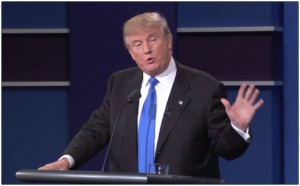Donald Trump effectively took control of the gun control issue at last week’s presidential debate with simple logic; felons and anybody in the act of committing a crime shouldn’t have guns, they never should have been able to and “gun control” can simply mean enforcing the law. However, an easy and effective method of enforcing the law has been attacked by Clinton who attempted to make stop-and-frisk policing appear unconstitutional at the first presidential debate.

During the beginning of the gun control discussion Clinton immediately defended that stop-and-frisk police tactics are unconstitutional. This tactic involves an officer who finds reasonable suspicion of a crime occurring or about to occur and thus, can tap down the outside of an individual’s clothing in order to ensure the individual does not have a weapon. If a weapons is found an arrest can occur.
Despites Clinton’s claim, stop-and-frisk tactics were named legal in 1968 with the Supreme Court decision of Terry v. Ohio:
“Where a reasonably prudent officer is warranted in the circumstances of a given case in believing that his safety or that of others is endangered, he may make a reasonable search for weapons of the person believed by him to be armed and dangerous regardless of whether he has probable cause to arrest that individual for crime or the absolute certainty that the individual is armed.”
The case continues to explain that in a moment of safety when an officer cannot get a warrant “to neutralize the threat of physical harm, take necessary measures to determine whether that person is carrying a weapon.”
This case has never been overturned; it was decided on an 8-1 decision as law of the land. Clinton cannot claim stop-and-frisk was made illegal. However, she is not completely wrong. Stop-and-frisk procedure was abused once and thus, District Court Judge Shira Scheindlin ruled that the way in which it was being administered in New York City at the time was unconstitutional.
As Rudolph Giuliani, former New York City Mayor, explained in the Wall Street Journal, under his administration with Commissioners William Bratton, Howard Safir and Bernard Kerik the number of stop-and-frisks always fell short of 100,000. The tactic’s use was expanded under Mayor Michael Bloomberg and Commissioner Ray Kelly to about 600,000 since 2013.
This is when the practice was overused and the way it was administered began violating individual rights. The tactic is not a problem. The police are not a problem. In that case the administration was the problem.
For Democrats who call for gun control, stop-and-frisk is a tactic that prevents people who legally should not be carrying a gun from having one. It also serves as a strong deterrent to gun possession by would-be criminals. Rather than complicating gun ownership for legal gun owners, stop-and-frisk is an aggressive way to ensure those most dangerous do not have the tools needed to commit crimes.
Stop-and-frisk also provides law enforcement with an in the moment response to potentially dangerous situations without risking the lives of many by waiting for potential escalation.
This tactic is a pillar to a law and order campaign such as Trump’s, as it was Giuliani’s two decades ago. The concept is simple; those who are not dangerous or committing crimes will have no problem, while those who are will no longer be a threat. Rather than controlling every one’s guns, control those who are committing crimes in order to execute the law and enforce order.
While Clinton continues her claim of stop-and-frisk’s unconstitutionality and supposed racism, Giuliani provides this reminder about what actually occurred during the legal use of the practice: “It helped to change New York City from the crime capital of America to the safest large city in the country. In each of those 20 years [of stop-and-frisk], approximately six of 10 murder victims in New York City were African-Americans. In other words, stop and frisk saved many black lives.”
Natalia Castro is a contributing editor at Americans for Limited Government.





